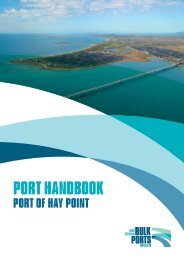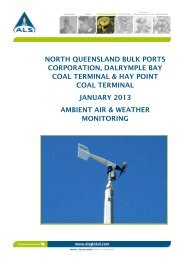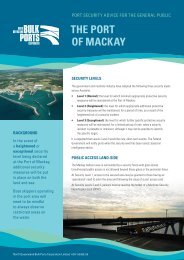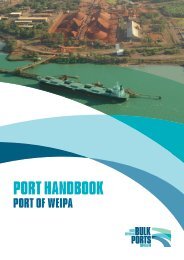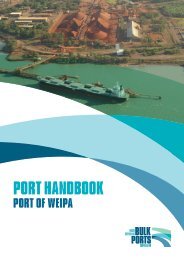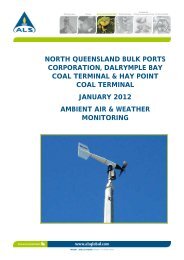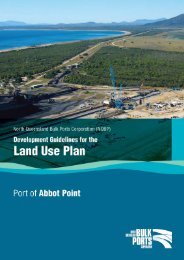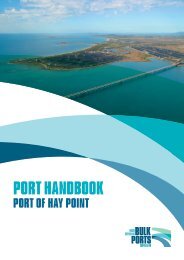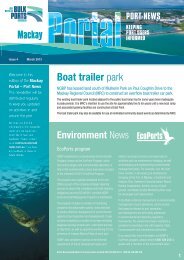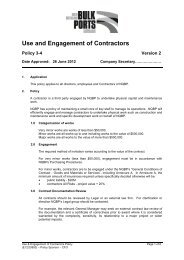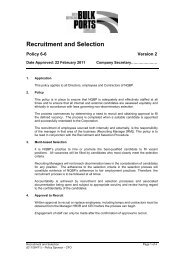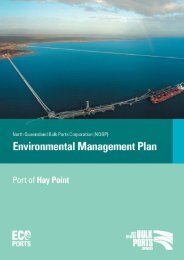Terms of Reference - North Queensland Bulk Ports Corporation
Terms of Reference - North Queensland Bulk Ports Corporation
Terms of Reference - North Queensland Bulk Ports Corporation
- No tags were found...
You also want an ePaper? Increase the reach of your titles
YUMPU automatically turns print PDFs into web optimized ePapers that Google loves.
• hazardous materials to be stored and used on site, including environmental toxicitydata and biodegradability• generation <strong>of</strong> ship-sourced wastes (see also Part B, Section 5.10.5).5.9.2. Waste managementAssess the potential impact <strong>of</strong> all wastes generated during construction and operation,with regard for best practice waste management strategies in accordance with theWaste Reduction and Recycling Act.Provide details <strong>of</strong> waste management strategies (including reduction, re-use, recycling,storage, transport and disposal <strong>of</strong> waste). Demonstrate that waste minimisation andcleaner production techniques and designs will be implemented to prevent or minimiseenvironmental impacts when selecting processes, equipment and facilities.Provide details <strong>of</strong> each waste in terms <strong>of</strong>:• the options available for avoidance/minimisation• operational handling and fate <strong>of</strong> all wastes including storage• on-site treatment methods proposed for any wastes• methods <strong>of</strong> disposal (including the need to transport wastes <strong>of</strong>f site for disposal)proposed to be used for any trade wastes, liquid wastes and solid wastes• the potential level <strong>of</strong> impact on environmental values• measures to ensure stability <strong>of</strong> the waste storage areas and impoundments• methods to prevent seepage and contamination <strong>of</strong> groundwater from stockpilesand/or storage areas and impoundments• measures to minimise attraction <strong>of</strong> vermin, insects and pests• options available for using recycled materials• market demand for recyclable waste (where appropriate)• decommissioning <strong>of</strong> the construction site.Provide details <strong>of</strong> cleaner production waste management planning, especially howthese concepts will be applied to prevent or minimise environmental impacts at eachstage <strong>of</strong> the proposal. Discuss measures to improve natural resource use efficiency (forexample, energy and water), integrated processing design, any co-generation <strong>of</strong> powerand by-product re-use as shown in a material/energy flow analysis.Assess the hazardous nature <strong>of</strong> any structures or materials found on site that need tobe handled accordingly with relevant legislation (including the Public Health Act 2005(Qld) and Workplace Health and Safety Act 2011 (Qld)), national codes <strong>of</strong> practice(Code <strong>of</strong> Practice for the Management and Control <strong>of</strong> Asbestos in WorkplacesNOHSC:2018(2005) and Code <strong>of</strong> Practice for the Safe Removal <strong>of</strong> Asbestos, 2ndEdition NOHSC: 2002(2005)).Address the requirements <strong>of</strong> the Transport Operations (Marine Pollution) Act 1995(Qld) and the Transport Operations (Marine Pollution) Regulation 2008 as they apply toship-sourced pollution.Contents <strong>of</strong> the EISDudgeon Point Coal Terminals Project<strong>Terms</strong> <strong>of</strong> reference for an environmental impact statement- 51 -



